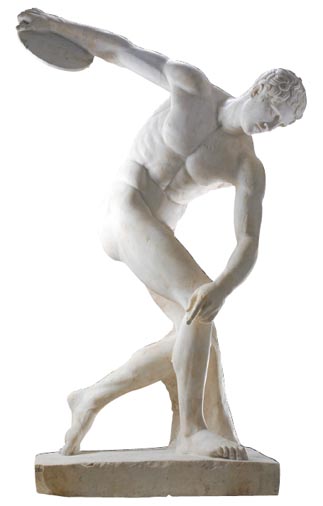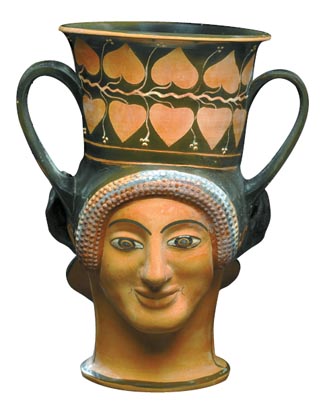Exhibit lets bizarre creatures mingle with the gods

“Diskobolos,” a 2nd-century Roman marble copy of the lost bronze original by the Greek sculptor Myron in the middle of the 5th century B.C. ⓒ The Trustees of the British Museum
The show, which is being held in the museum’s Special Exhibition Gallery, has more than 130 pieces from the British Museum, including the famous marble “Diskobolos.”
The first section in the exhibit shows sculptures of Greek gods such as Zeus and Dionysus, heros such as Herakles (Hercules) and monsters such as the Sphinx. This section also includes amphoras whose surfaces are painted with scenes from Greek mythology. The marble sculpture of the Sphinx - with its very classic human head, the body of lioness and wings - has a particularly grotesque beauty.

“Kantharos,” or “Red-figured drinking cup,” made in Athens, 470-460 B.C. ⓒ The Trustees of the British Museum
The second section highlights the physical ideals of the ancient Greeks, with marble sculptures of male nudes. The section also includes bizarre or satirical human figures, including a wine cup with a figure of a bearded satyr on one side and that of a maenad on the other. Both were wild followers of the wine god Dionysus.
The third section, which is about the Olympic Games, shows sculptures including Diskobolos and pottery depicting various scenes of athletic competition. The competitions were not only part of training for battle but also a way to create a healthy body, which the ancient Greeks held in high regard.
The fourth section has less famous pieces, but it might be the most interesting. It deals with the daily life of the ancient Greeks from birth through marriage, war and death.
There are pieces of armor, which each Greek male had to secure when he was an adult in order to participate in wars, and a makeup case with paintings depicting a woman’s daily life at home. There are also gravestones, showing the values of the ancient Greeks, and amphoras with paintings showing the erotic life of the Greeks, including homosexuality.
This section also has pieces from the Hellenistic-period that, unlike pieces from the Classic period that pursued ideal forms, show the lives of the people in a realistic manner.
“Whereas early Greek art generalized the human form and chiefly depicted ruling class values, later Greek art included depictions of people with a diverse range of characteristics,” Shin said. “This stemmed from the interchange with various other peoples, which was a result of Alexander the Great’s territorial expansion and conquests.”
The exhibition is part of the National Museum of Korea’s “The Great Civilizations of the World” series, which included “Glory of Persia” in 2008, “Egypt, the Great Civilization” and “The Great Myth and Mystery of Peruvian Civilization, Inca” in 2009.
The exhibition runs until Aug. 29. Admission is 10,000 won ($8.80) for adults. The museum opens at 9:00 a.m. It closes at 9:00 p.m. on Wednesdays and Saturdays, at 7 p.m. on Sundays and at 6:00 p.m. on other weekdays. The museum is closed on Mondays. Go to Ichon Station, line No. 4, exit 2. For more information, visit www.museum.go.kr.
By Moon So-young [symoon@joongang.co.kr]










with the Korea JoongAng Daily
To write comments, please log in to one of the accounts.
Standards Board Policy (0/250자)